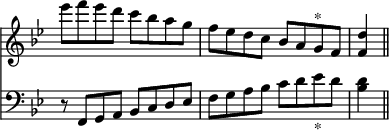A Dictionary of Music and Musicians/Contrary Motion
Jump to navigation
Jump to search


 from the first movement of Beethoven's Sonata in B♭, op. 106.
from the first movement of Beethoven's Sonata in B♭, op. 106.
CONTRARY MOTION is the progression of parts in opposite directions, one or more ascending while the other or others descend, as—

In contrapuntal music it was considered preferable to similar or oblique motion, and it always has a stronger and more vigorous character than either of these. Many conspicuous examples of its use in modern music may be found, as for instance in the slow movement of Beethoven's Symphony in C minor—

Passing notes are allowed to progress continuously by contrary motion until they arrive at notes which form a part of some definite harmony ( * ), as—

[ C. H. H. P. ]